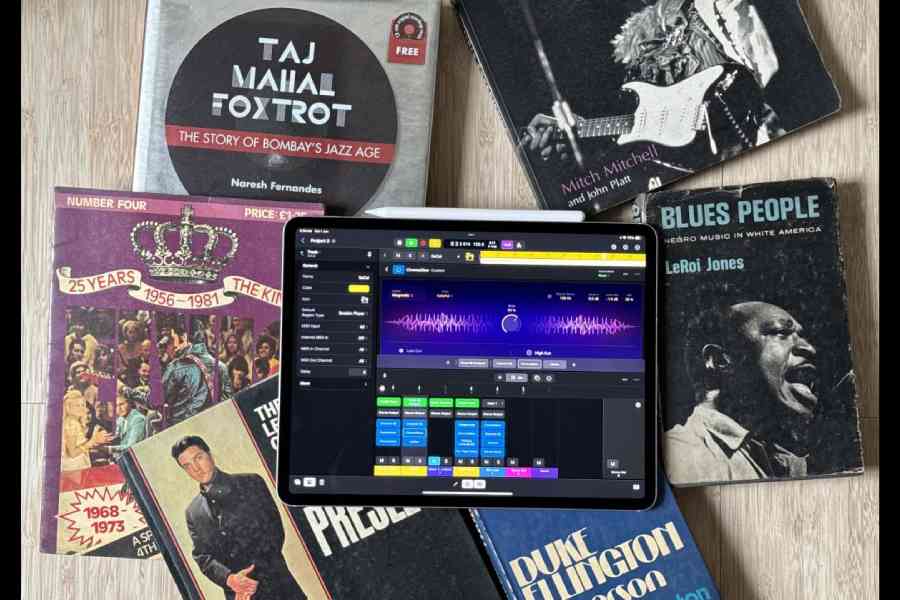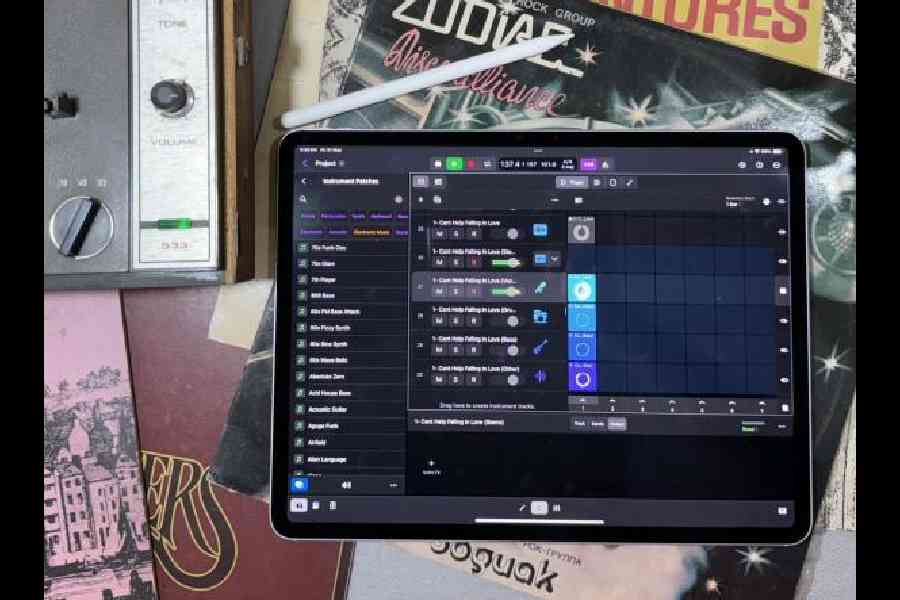For years, Logic Pro has remained a valuable offering from Apple. The new version of Logic Pro promises a new era for digital audio workstations (DAW). Fun has come in heaps in the last few weeks while composing beats, riffs and rhythms using the iPad version and surprisingly, the company hasn’t dumbed it down at all; instead it takes full advantage of the touchscreen interface to offer the same power as one is entitled to on a Mac. The latest version of the software ensures musicians can work on their projects comfortably from a sofa as much as on a plane.
I used the iPad Air with M2 to work on Logic Pro and the minimum install comes around 1GB but you will need 30-odd GB for all the instruments, loops, and other free material.
Sessions players
The focus this time seems to be around AI, which is also a trend in music production. One of the most appealing changes may appear small but it enhances the workflow a million times.
When you create a new track, the interface will look different. One of the most exciting options that will show up is Session Player, which is based on AI-generated players. The idea is to replicate the work of a sessions player. Great ideas often come at a time when fellow musicians are not around. Session Players is an AI-driven backing band that responds directly to feedback. You can choose a drummer, a keyboard player and a virtual bass player.

Session Players offer groundbreaking experiences for creators by providing a personal, AI-driven backing band that responds directly to feedback
I started the project with a keyboard player. Right out of the gate, there is something simple to work with. The chord progression is basic but I quickly move to something more uptempo. It’s easy to punch in some chords manually and then let Session Players do its thing. The insertion — E minor seventh, F sharp minor seventh and G major seventh — gets done with a MIDI input. The complexity level can be dialled up or down and the same goes for “fill amount”.
Well, that sounds good but there’s something missing — it’s time for another Session Players and the new player has an electric keys patch with low “complexity” level to jive with the grand piano player. A minor tweak to the “complexity” level can switch up the performance, so be careful when playing with the dial.
With Keyboard Player, users can choose from four different styles, designed in cooperation with top studio musicians. Using Studio Piano plug-in, users can select additional sound-shaping options, with the ability to adjust three mic positions, pedal noise, key noise, release samples, and sympathetic resonance.
There is an option to bring in a drummer and there are several styles to choose from — pop rock to indie disco, Neo soul to modern Motown. Next, a bass player joins in. Users have the option to choose from eight different bass players and guide their performance with controls for complexity and intensity, while leveraging advanced parameters for slides, mutes, dead notes, and pickup hits. Bass Player can jam along with chord progressions, or users can choose from 100 bass player loops to draw new inspiration.
Any tweak to any of the players will automatically rework the entire sound. There is always the option of adding live music input to perk things up.

ChromaGlow models the sounds produced by a blend of revered studio hardware by leveraging AI and the power of M-series Apple silicon
ChromaGlow
I am not a musician but getting a hang of the software is fun and once you meddle for a few hours, you would want to push the sound. ChromaGlow is a unique plugin which brings the texture of coveted analogue hardware to your music. By using AI, it models the warmth and presence of classic studio hardware.
The interface is simple — a single knob sits in the centre but there are plenty of layers to the design. You can choose from five models: Retro Tube, Modern Tube, Magnetic, Squeeze, and Analog Preamp. Each model changes the function of the central knob.
A personal favourite is Modern Tube because of the warmth it offers and so does Squeeze (with style set to Hard Press). These add some cool attitude to the music.
Stem Splitter
It’s an invaluable tool that leverages AI and machine learning of Apple silicon to extract up to four different stems — vocals, drums, bass and other instruments — from a single audio file.
The feature will come in handy when remixing, remastering or extracting samples where the original multitrack recording is unavailable. The precision you are looking at is extremely high.
Since I am using iPad Air with M2 chip, the Stem Splitter took only a few seconds to split something as complicated as Elvis Presley’s Can’t Help Falling in Love.
The feature appears to enhance the spatial and dynamic qualities of the original recording, ensuring a polished, high-quality final sound. Overall, the separation is pretty dang good when compared to something like Acoustica. There is rarely any vocal bleeding into the other instruments. Further, if you are stem splitting tracks with plenty of drumming, you will find no choppiness on Logic Pro. In some tracks, taking out the drums takes out a bit of sibilance of some words but it’s rare.

With Stem Splitter, an artiste can recover moments of inspiration from any audio file and separate nearly any mixed audio recording into four distinct parts
Should you buy it?
The latest version of Logic Pro is a perfect example of meaningful implementation of artificial intelligence. Like Logic Pro for Mac, the iPad offering has plenty of instruments, like synthesisers, drums, guitars, electric pianos, organs and arpeggiated sequences, besides a ton of royalty-free loops, all waiting to be dragged to the Tracks area.
There is also the option to record with the built-in mic, which does a decent job. But for professional-quality sound, you need to use a good microphone.
Having the Magic Keyboard and Apple Pencil Pro are a bonus. Since I have been using the Magic Keyboard for some years, shortcuts come easily to me. The Apple Pencil helps massively with drawing in curves.
The level of flexibility Logic Pro on the iPad offers is exceptional. It’s also a great option for GarageBand users who want to take their music to the next level or musicians who want to buy a no-nonsense music software studio.
Logic Pro for the Mac has been used by the likes of Taylor Swift and Ed Sheeran for years and having the ability to use it on the iPad highlights the flexibility of the software as well as the power of Apple devices and silicon.
At a glance
Software: All-new Logic Pro for iPad 2
Price: Rs 499 per month or Rs 4,999 per year
High notes
Offers the same power of Logic Pro for Mac
Meaningful implementation of AI with Session Players
Excellent support for Apple Pencil
Good value for money
Muffled note
May overwhelm newcomers at first










